WIP – text has lots of errors. Will correct. 5 feb 2017
Community Games
On Wednesday, 19th April, 1978 a public meeting was held in Taughmaconnell Community Centre re. The Community Games. 15 people attended. The meeting was chaired by Sdamus Kelly and Mary Galvin acted as Secretary. Iimmy Lyons was the man rvith the information on “The Community Games” and it was agreed by all present that the children of Taughmaconnell would benefit by becoming involved.
The athletics were held in Val Keoghs field that was used by the soccer club at the time. This remained the venue until Onagh Park was opened in 1984. The soccer club has kindly facilitated athletics events each year.
In 1978, the first year the Parish of Thughmaconnell became involved the children participated in athletics and soccer. By 1979 they broadened the scope to include Handball and Gaelic as well as Soccer and Athletics. The number of activities entered has varied as the years went by. Due to the relatively small catchment area it is difficult to participate in the various team events. In the early years Handball teams were to the fore in the county winning Gold Medals on a number of occasions. Since the mid eighties handball has not featured as an event in this area. However, Athletics is where
the main emphasis has been placed and probably is the most successful medal stakes. Taughmaconnell has been represented at the National Finals of Community Games in Choir in 1990, and Athletics virtually on an annual basis.
The first Gold Medal at National level to be won by a child from Taughmaconnell was in the Girls – Under 12, 1OOmetres and won by Bemadette Finneran in 1985. In 1986 Ursula Brooks won Silver in the Girls – Under 10, 1OOmetres while Anthony Galvin took Bronze in the Boys – Under 13, Walk. In 1988 the Girls – Under 17, Relay team consisting of Dolores Mulleady, Siobhan Lyons, Bernadette Finneran, Mary Brooks and Sheila Lyons took Bronze medals. 1989 was another memorable year at the National Finals when Bernadette Finneran took her second Community Games National Title, this time in the Girls – Under 16, 100 metres. The Girls – under 17, Relay team went one better than the previous year by taking second place. Success in
Athletics continued into 1990 when Ursula Brooks won a Silver Medal in the Girls -under 14, Long Iump. Medals at National level had eluded the participants from Taughmaconnell for a nurnber of years although the area was still represented at the finals practically every year. Sharon Corbett put an end to the barren spell in 1999 when she won a Gold Medal at the Community Games National Finals in the Girls – Under 14, Shot Putt. In recent years the events in which the Parish of Taughmaconnell has participated in include Athletics, Soccer – Boys and Girls, Rugby, Swimming, Gymnastics, Art and Handwriting.
Jimmy Lyons has been a stalwart in Community Games since the inaugural meeting in 1978. Many other people have also given of their time and enerry to ensure that the children of the locality derive satisfaction, enjoyment and a sense of achievement from participating in Community Games.
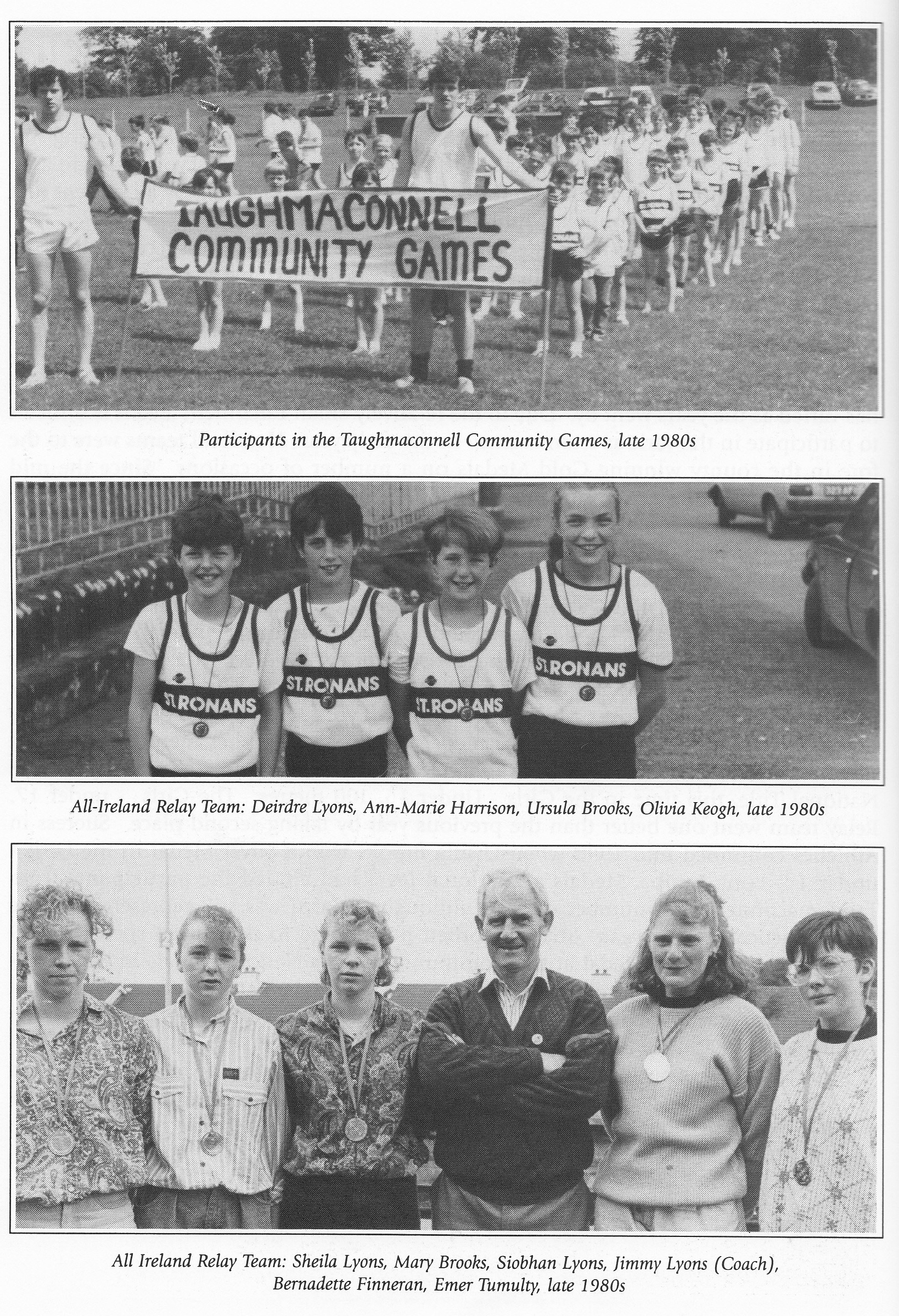
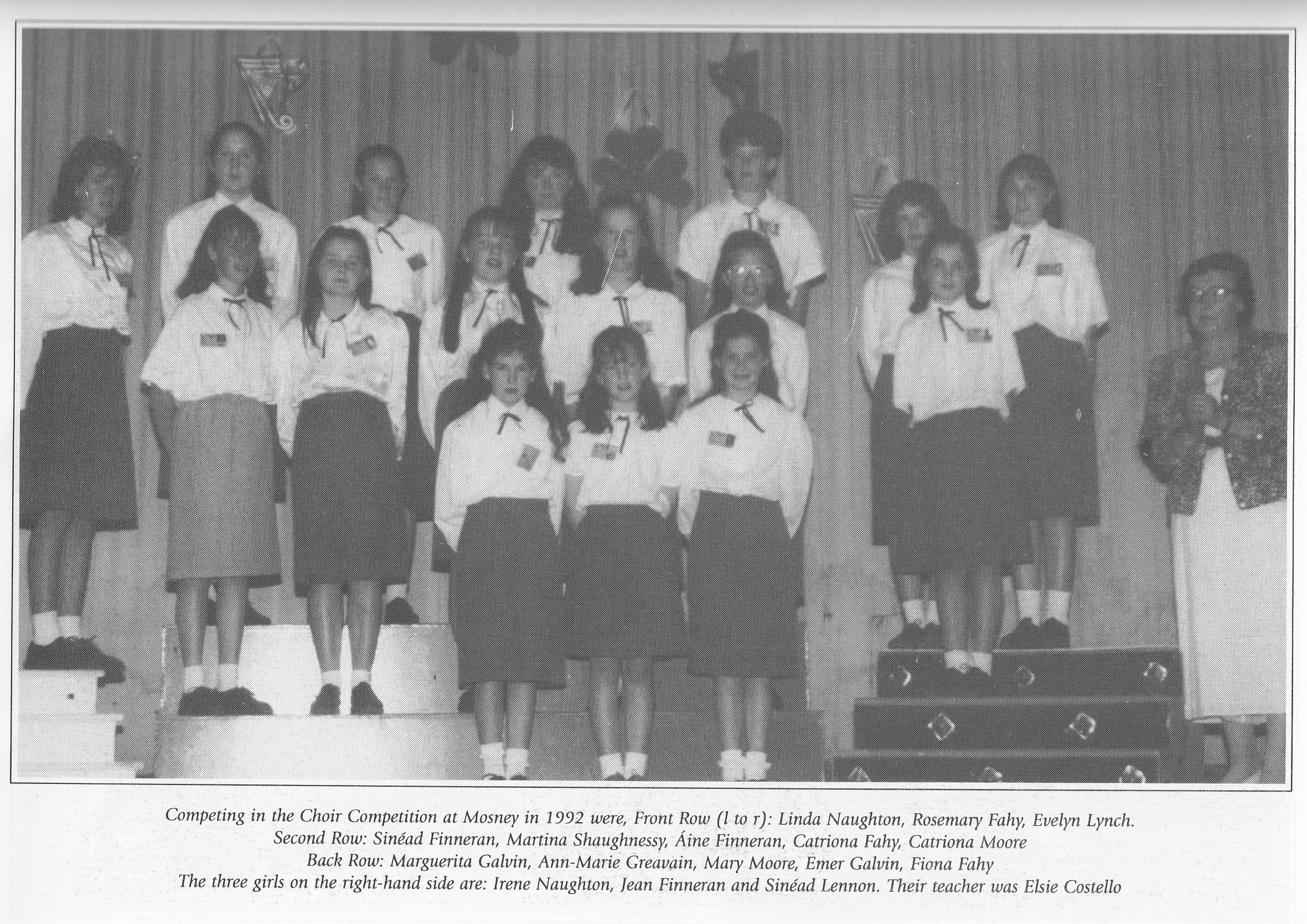 The Early days of Taughmaconnell & Padraig Pearses GAA
The Early days of Taughmaconnell & Padraig Pearses GAA
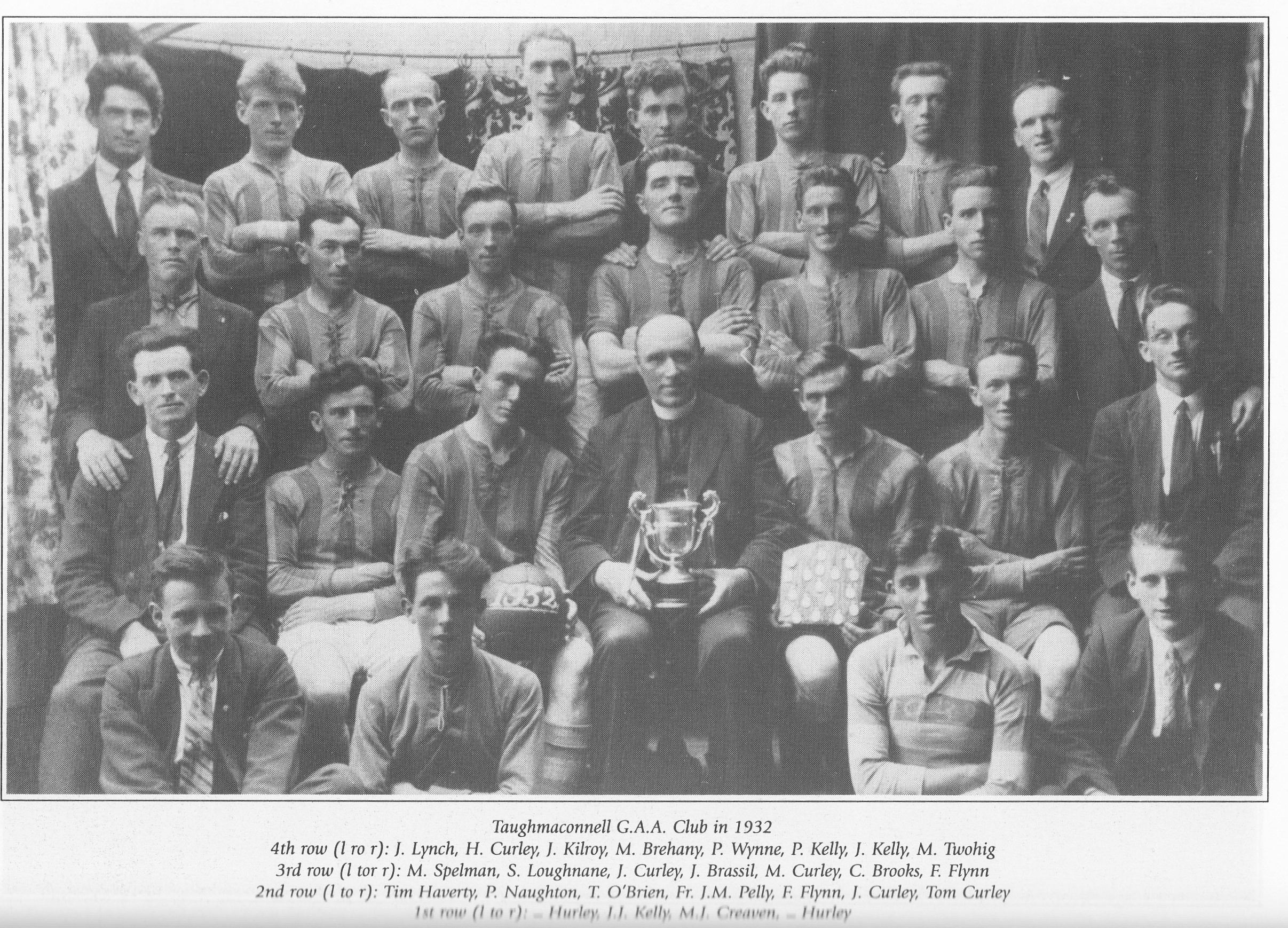 The following is on occount of the early days of Taughmaconnell G.A.A. as giuen by Mr. Hughie Curley.
The following is on occount of the early days of Taughmaconnell G.A.A. as giuen by Mr. Hughie Curley.
G.A.A club structure was non-existent in Taughmaconnell prior to 1929 until the establishment of the O’Meara Cup. One of the first games to be played by”
Taughmaconnell team was against Curraghboy in M.l. Fallon’s field in 1927.
Taughmaconnell’s first competitive game was played in the O’Meara Cup on the 8th December 1929 against Drum. The venue for that game was in the grounds of Gentex Factory then known as the Ranelagh, and was won by the Taughmaconnell team. The first O’Meara Cup was run between the years of tgZg and 1930 with the final being played in Iune of tgEO between Taughmaconnell and Athlone with Taughmaconnell emerging victorious on that occasion. The next playing of the O’Meara cup was held between the years of 1931 and 1932. The final of tg32 was contested berween
Thughmaconnell and Clonown with Taughmaconnell retaining the O’Meara Cup. The O’Meara Cup of 1933-1934 once again saw Taughmaconnell contest the final this time their opponents being St.Iohns, on this occasion Taughmaconnell were beaten.
The O’Meara Cup was played on a league system with all the teams playing games on a home and away basis. Some of the teams, who took part in those early days, were Moore, Clonown, Drum, Kiltoom, St. John’s, Bealanamulla and also Shannon Rovers. Early referees in the competition included Frank Murray, Ned Killeen and Bertie Watson. The horne matches that were played by the Taughmaconnell team took place in Joe Lynch’s of Shraduff and then progressed to Michael Moore’s of Kilkenny. It is recalled that stones were often blasted on a Saturday night in order to get the field ready for Sunday.
The first strip to be worn by the Taughmaconnell team was a green and gold jersey. When matches were played in Athlone it was common practice for the Taughmaconnell team to tog out in Kirby’s Pub in Baylough. Iohn NcNeill’s lorry was the main form of transport used by the team for commuting to away matches. It was often said that -VcNeill’s Lorry Kirby’s Porter and O’Meara’s Cup were the three main ingredients behind the success of that early Taughmaconnell team. In order for the club to survive and cover its expenses a fee was collected at the gate at each home game with 6 old pence being the entrance fee.
In 1934 Thughmaconnell also played Ballyforan in the McCarn Cup. This was also the official opening game of St.Aidan’s current pitch. In that game Patsy Mulvey came on for Taughmaconnell, although his name was not on the list and an objection was subsequently raised by Ballyforan. Taughmaconnell refused to play in the replay. After that game a large proportion of that great Taughmaconnell team retired from playing football.
Much of the gaelic football played in the Parish during the 1940’s took place on the rroperty of Mr John Costello, Onagh, Thughmaconnell. The players which played for traughmaconnell on the tedm of 1942 were as follows: Pakie Clogher Ned Clogher, Martin |oe Kelly , loe Brooks , Pat Downey , Michael Mannion, Joe Mannion (RIP), Jim Mannion (RIP), Martin Finneran, Paddy Moore, )oe Moore, Tommie Grehan, Tommie Kelly, Pakie Kelly, Charlie Brooks (RIP), Ned Murray, Ned Dolan, Tom Kileen, Tommie Francis Kileen, Josie Creavin, Pat Rogerson (RIP), Iohn Feely, Frank Brooks, Arthur Moore, Fr, Harry Butler, |immy Cooney, Ronan Cooney, fohnny Cooney and |oe Galvin (RIP).
The Taughmaconnell team continued to play up until the early 1960’s when at this point they ioined with Moore and Creagh to form Padraig Pearses. In the years prior to this, Taughmaconnell enjoyed success at both minor and junior level. During the 1950’s Taughmaconnell once again won the O’Meara Cup but never received it. During this decade Taughmaconnell also joined with St. Peters to win three minor titles in a row in 1957, 1958 and 1959. In the early 1960’s Taughmaconnell also played in two county junior finals. In 1960 Thughmaconnell played Oran in the iunior county semi-final in Ballyforan with the result being a draw. The replay was held in Knockcroghery with the results being 2-l to 0-6 to Taughmaconnell. Taughmaconnell went on to be beaten by Kilmurray in the final of that year. In 1961 Taughmaconnell once again played in the county junior final that was held in Knockcroghery but on this occasion
they were beaten by Strokestown. The Taughmaconnell Juvenile team also contested the county final of that year against Castlerea. On. this occasion the Taughmaconnell uveniles emerged victorious beating Castlerea by 4 goals -4 points to 11 points. During this period Taughmaconnell played in Lynch’s of Shraduff before moving to Paddy Finneran’s in Onagh.
After the end of the 1961 season Padraig Pearses was formed. No county final was played in 1962 due to the fact that Roscommon played in the All-Ireland final of that year. The 1962 final was subsequently played in 1963 and St. Bridget’s beat Pearses by one point in that game. In the first round of the 1963, 1964, and 1965 seasons Padraig Pearses were beaten by Clan na Gael in the first round each time. Padraig Pearses also contested the final of 1968 but were defeated by Castlerea on that occasion. It is also important to note that a Thughmaconnell man played a large role in Castlerea’s victory
on that day. Mr Ronan Kelly of Dundonnell who at the time was resident in Castlerea scored four points from play for the winners. To date this has been the last county final to be contested by a senior Padraig Pearses senior football team.
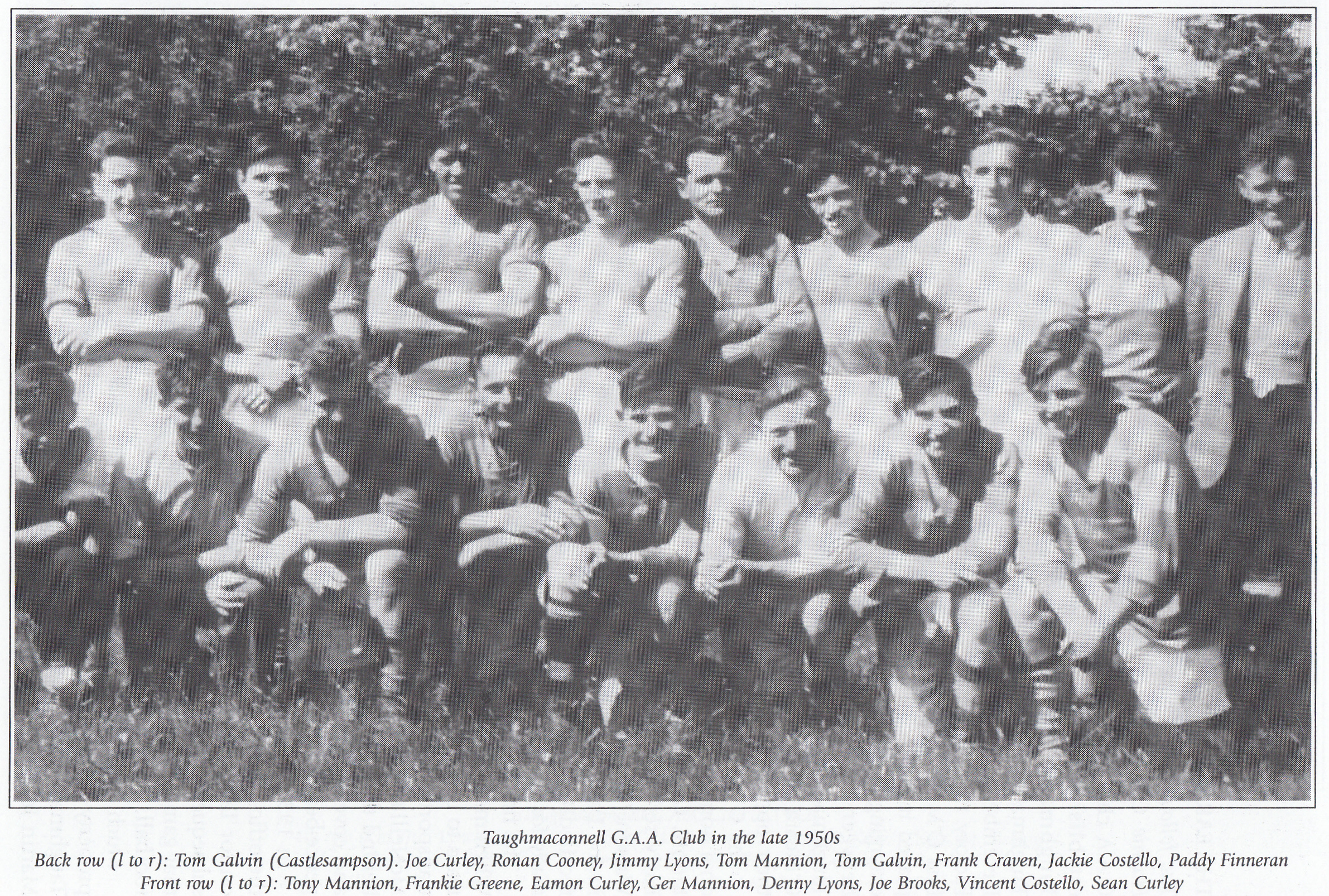
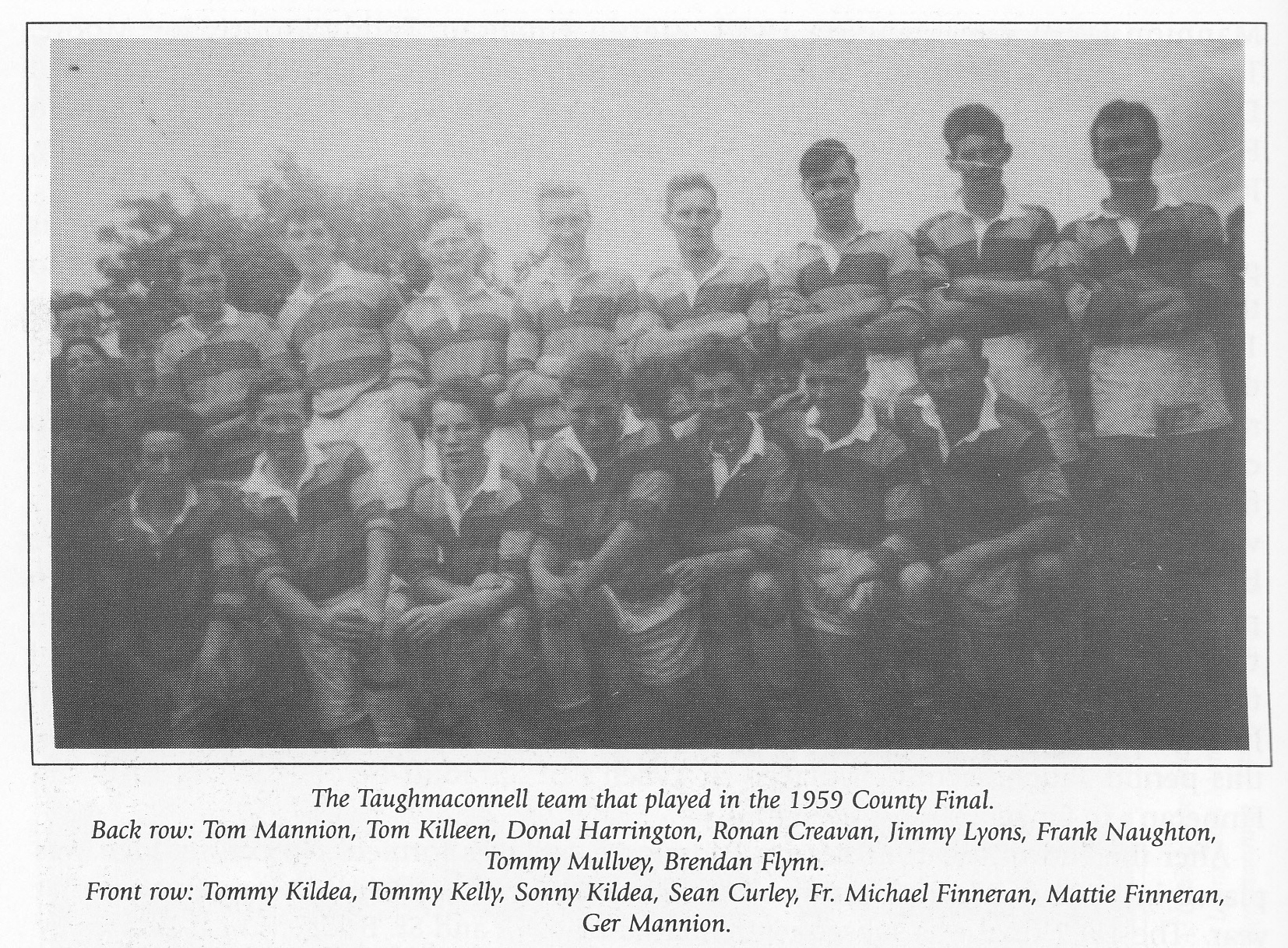
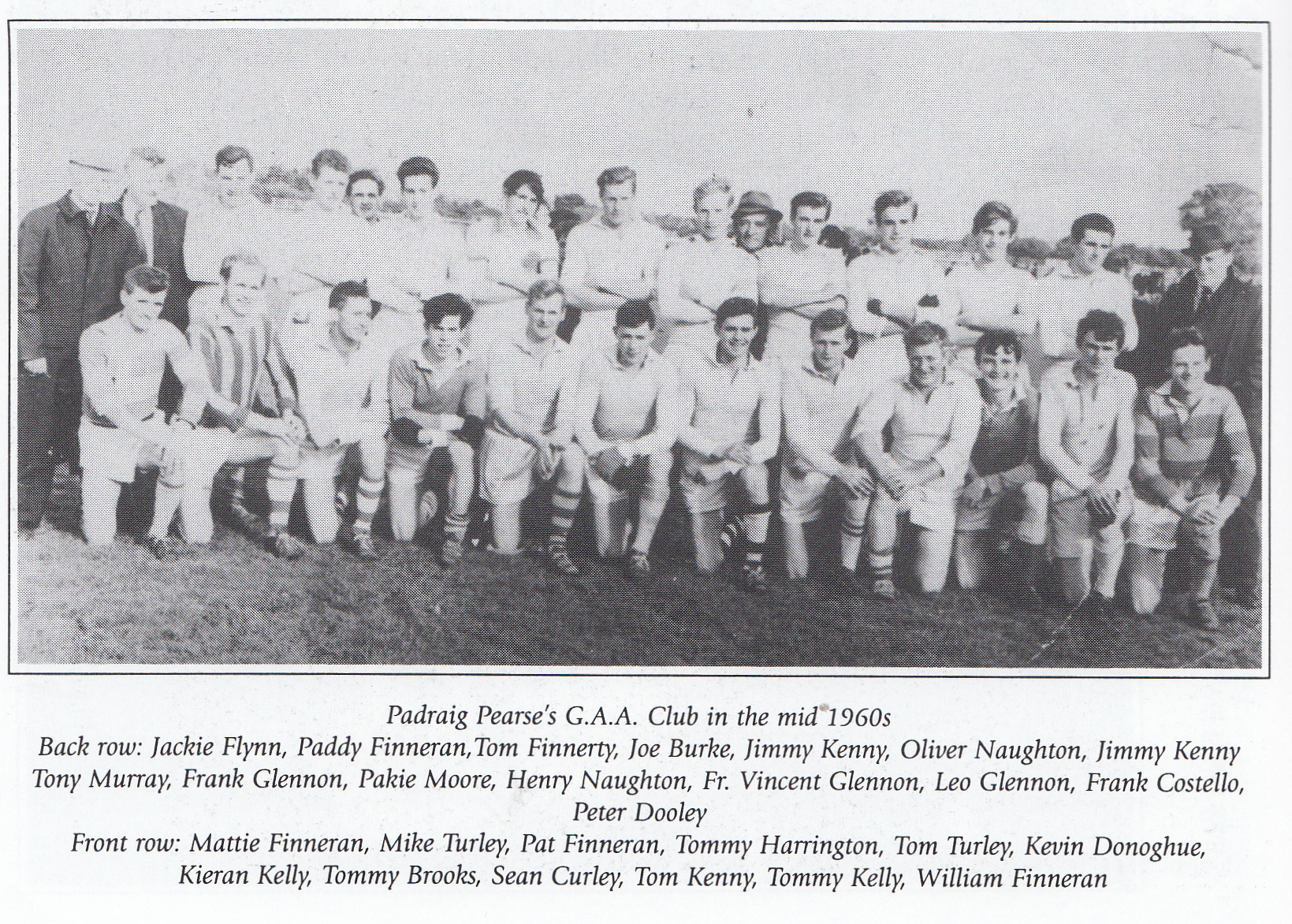
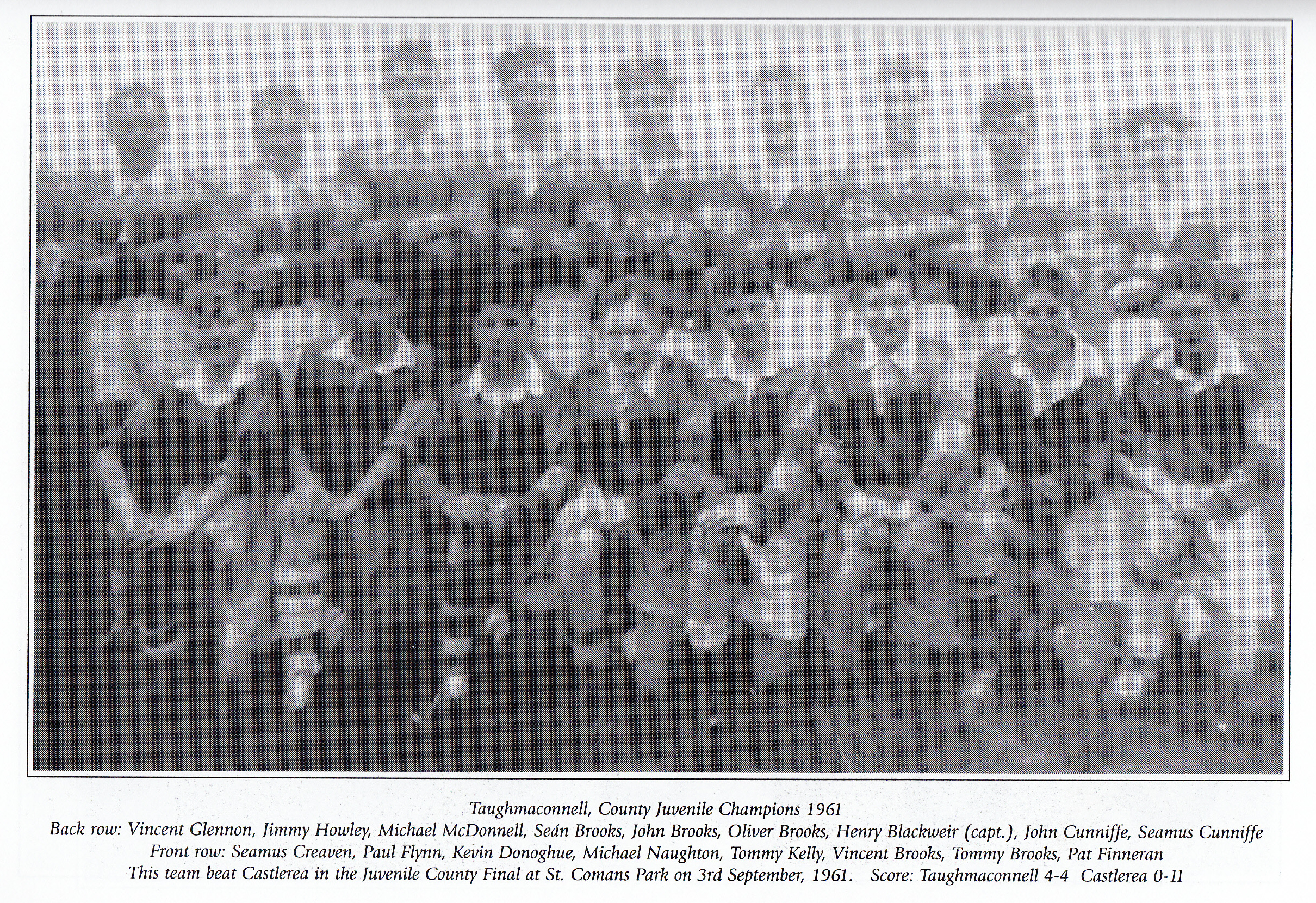
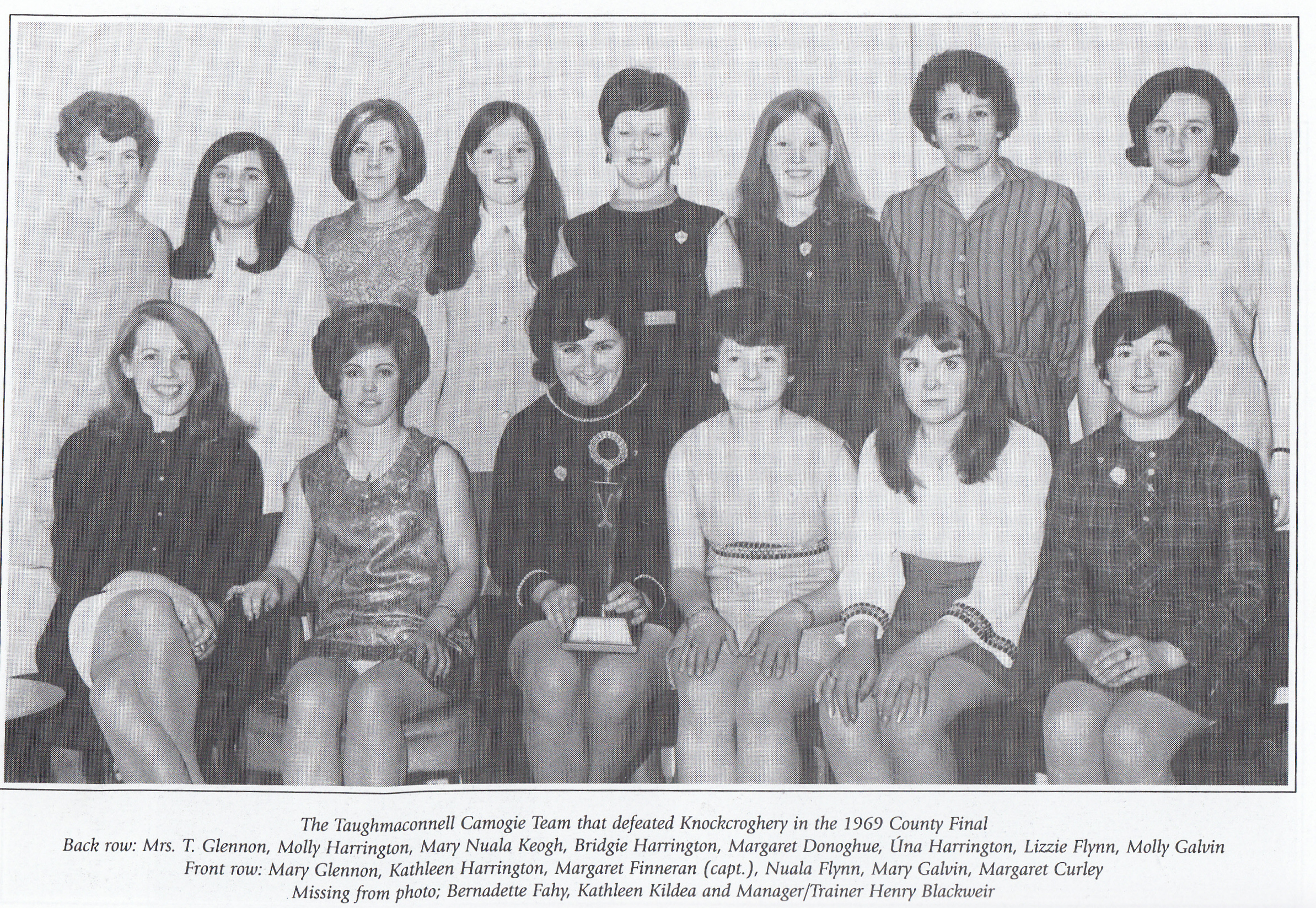
Handball
The game of handball is one of our ancient Irish games. Its origin dates back to the time of the Tailteann games and Taughmaconnell played its part in it. Handball was played in different areas in Taughmaconnell. It was played against the gable wall of ]immy Kilroy’s shed, his house is at least 200 years old. It was also played at Downey’s old house near Carrowduff Railway Station and at Tavanagh old school. The present ballalley was built in L947. The site was given by Mr. Paddy Finneran. Money to build this ballalley was raised by the local Drama Group who presented plays in the local hall and neighbouring parishes. It was built by Ioe Mannion and his sons of Castlesampson. ]ohn Corbett R.I.P., Onagh drew the sand with his own lorry from AthLuain pit, now Roadstone, for the building and the water was drawn from the bridge at
Jack Brooks R.l.P., Antrane with a horse and cart.
Founder members who attended at the start were as follows: Johnny Brooks R.I.P. (Racepark), Val Keogh R.I.P. (Feacle), Packie Creaven R.I.P. (Churchpark), fohnny Brooks R.I.P. (Kilatogher), Patsy Galvin R.l.P. (Dundonnell), )oe Gurry (Racepark), Pakie Clogher (Castlesampson), Paddy Finneran (Onagh), Jimmy Kilroy R.l.P. (Racepark), Michael Mannion (Culmore), Frank Creaven (Racepark) and John Corbett R.l.P. (Onagh)
The existing ballalley was roofed and re-opened in 7974 and the Club, under the leadership of Sonny Kildea, still included some of the founder members and a lot of new members. Many great players played in the alley including All-lreland champion Pat Kirby. Since then the club has organised many tournaments down the years including the Tommy Burke Memorial Trophy.
Sonny Kildea, Secretary, Taughmaconnell Handball Club (centre), presenting a trophy to All-lreland Champion, Pat Kirby (second t’rom right) in 1974
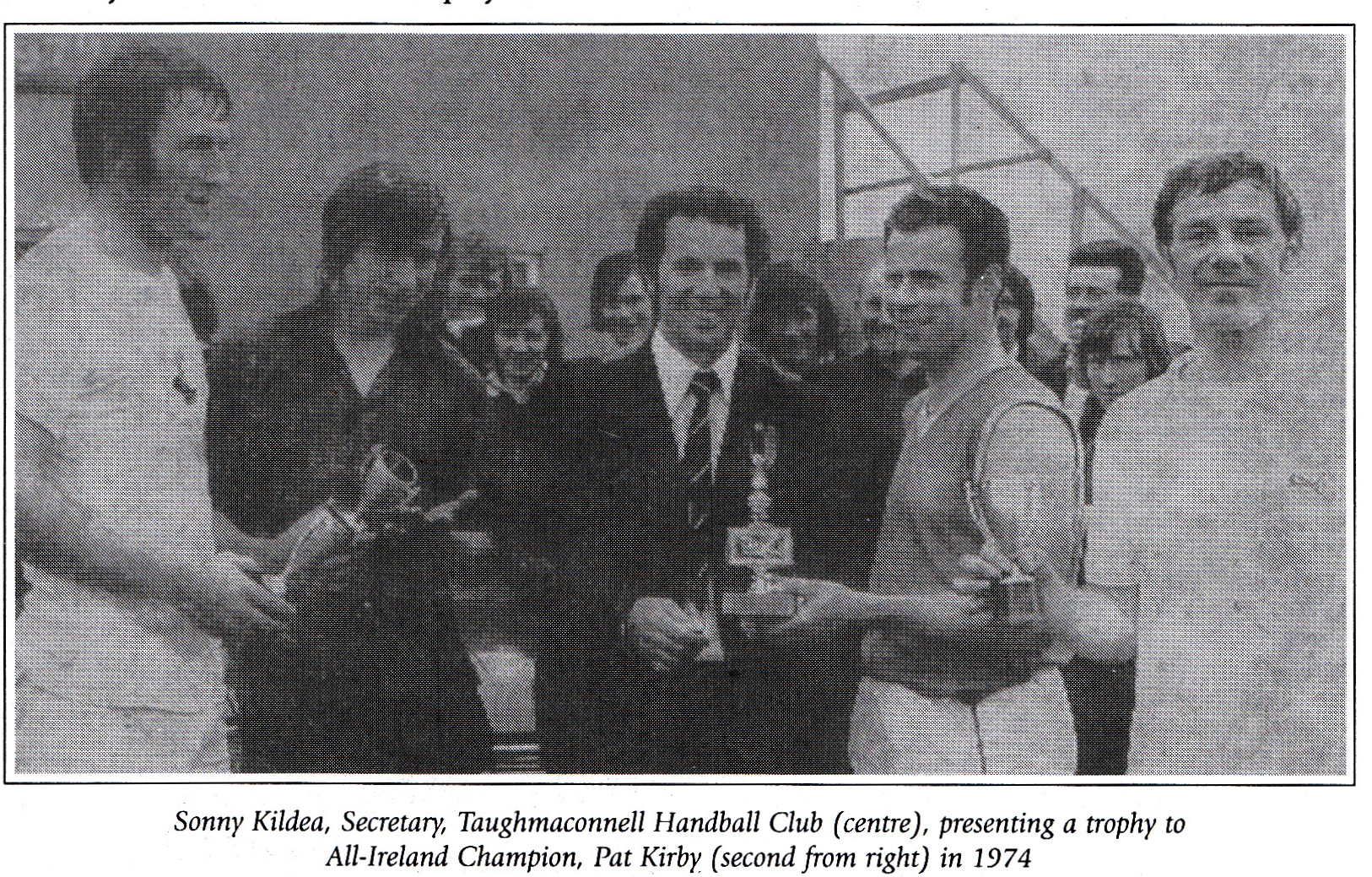

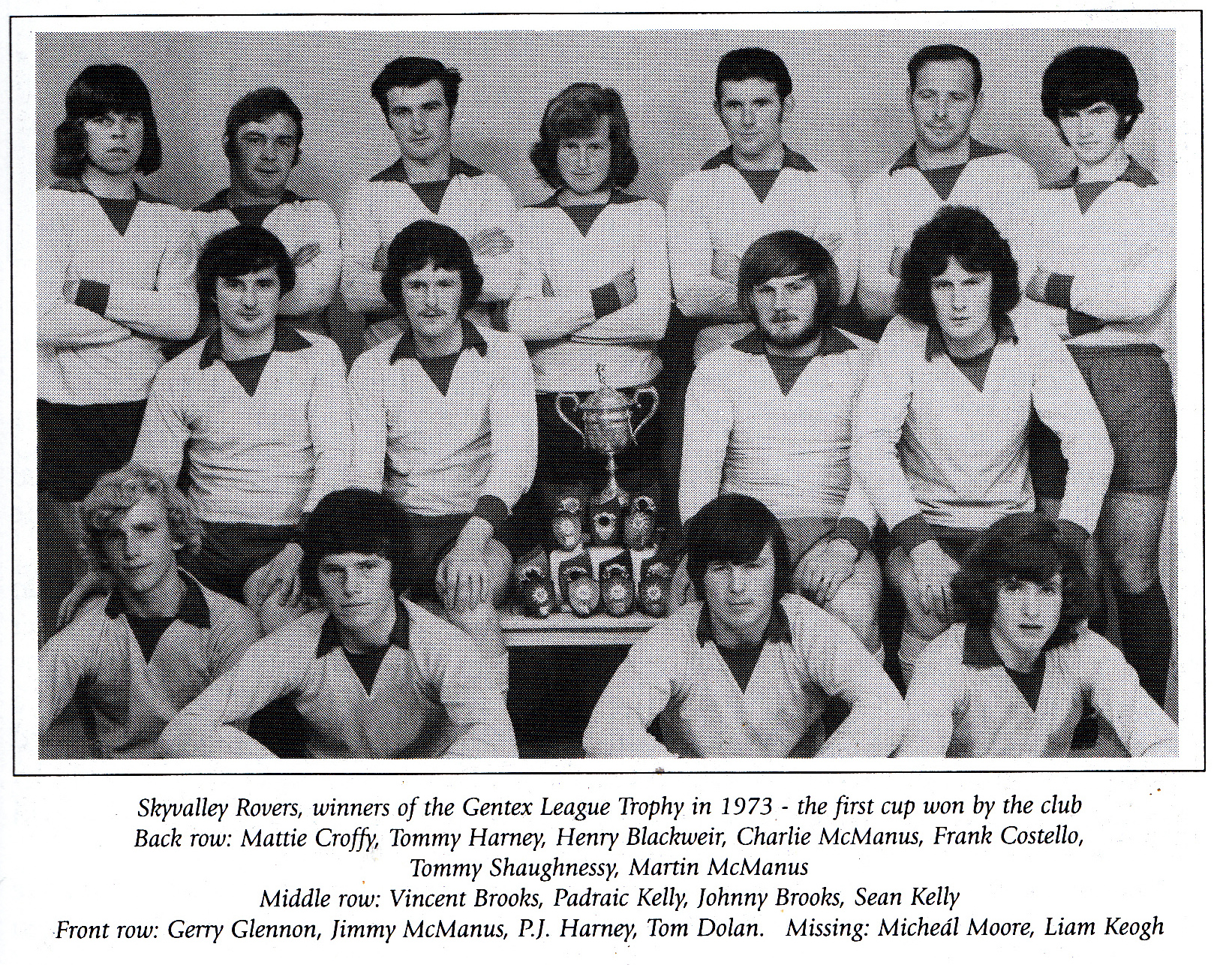
Skyvalley Rovers
Skyvalley Rovers, which is probably the most successful club in the Roscommon league, was founded at the end of 1970. The 1970 World Cup inspired a group of lads ::rainly from the Slgrvalley area of the Parish to play informal games in Paddy Moore’s :reld. They proceeded to play friendly matches in )anuary & February of 7971. Their first ever match was on 24th fanuary 1971 in a challenge against Southem Wanderers -.f Roscommon town and Johnny Cooney scored twice in a 2-1 win. The first couple of matches were played in Paddy Finneran’s field in Onagh.
In March of lg7l, the Roscommon & District League was formed & Rover’s Sean i.elly was elected as Vice-Chairman. Skyvalley’s first League match on 28th March, – 971 resulted in a 4-3 away win against Mosaics FC of Roscommon. At this stage the -lub had acquired the use of Val Keogh’s field in Fighill and this pitch was called Villa lark. The first game ptayed here was on 3rd April 7971 against Lanesboro. The match “:nished 1-1.
Rovers first set of jerseys were red and white but they had changed to their present :olours of yellow and blue by 1973. The first AGM of Skyvalley was held in the old FCA hut on 15th Dec 1971 with Val reogh elected as President, Vincent Brooks as Chairrnan, Sean Kelly as Secretary and Micheal Moore as Treasurer.
The first trophy won by Skyvalley was the Gentex League in Athlone in the summer of 7973. The Roscommon League was won for the first time in 1972 and it has been won on seven occasions in all. The Roscommon Cup has also been collected seven times by Rovers captains. In 1992 Skyvalley became the first team to win the league and cup double in Roscommon. In fact the Roscommon Cup success of that year was the third time in a row that they won that competition and they are also the only team to have won three cups in succession in Roscommon. The season gone by (1999|2OOO) has also been a very good one for Skyvalley as they won the double for the second time
to kick off the new century in style. In the thirty years of the Roscommon League the double has only been won on two occasions and both times it has been won by Skyvalley Rovers.

Rovers greatest success on the field of play was when they captured the Michael Byrne Cup in 1995 by beating Strand Celtic of Sligo by 3-1. This competition is for the winners of the four Junior Leagues in Connaught. In 1981 they entered a second team in the Roscommon League & also in that year they took the big step of purchasing a field from the Cusack family, in Onagh. After much work the ground was officially opened on 19th Aug 1984 by Pat Quigley of the FAI. The ground was blessed by Fr Iohn Egan P.P. and Athlone Town played a Roscommon league selection that day. In the summer of 1999 Skyvalley expanded further by buying a 2tf z acre site adjacent to Onagh Park. Once more this was sold by the Cusack family. This area will be developed early in the year 2000 and the club will be helped by a f 12,000 grant received from the National Lottery in 1999.
One of the reasons for the success of Skyvalley Rovers has been the fact that they are firmly rooted in Taughmaconnell. The vast majority of their players have always been drawn from the local Parish thus making it easier for locals to identifr with the club. At the moment Skyvalley are fielding a huge number of teams. They have two adult teams plus boys & girls teams from U-11 to U-18.
One of the great Skyvalley successes since their beginning has been the annual running of the senior Parish League. This League has been mn every year since 1972 and generally about 80 players from the Parish play in it. In the first final in 1972, Frank Costello’s team beat Vincent Brooks’ team 2-0 after a replay. Johnny Brooks scored the first goal & Frank Costello netted the second. Rovers also run a Parish League for National Schools kids and also one for players up to 16 years of age. The club is also active off the field of play and they have been organising trips to England for many years. Their first trip was to Liverpool in March 1973 to see Liverpool play Southampton. The’Pool’won 3-2 with Kevin Keegan scoring twice.
The future of Skyvalley Rovers looks bright. Soon they will have a set-up which will be the envy of most Junior Clubs in the country. Their ground at Onagh will have two full size pitches. In one way it is very appropriate that Skyvalley’s ground is in the rownland of Onagh. The Townland got its name because it used to be an old tribal meeting area. As well as a gathering place it used to also hold fairs, games and athletic contests. The games at Onagh were held in honour of the pagan gods Midhir and ronghus 69. The activities there were abolished by 900 A.D. and so after a break of over 1,000 years games and athletics have returned to Onagh. Onagh Park is used by St Ronan’s Athletic Club and the Taughmaconnell Community Games are held there every year.
Athletics
Even though St. Ronan’s Athletic Club was formed in 1974 there has been a history of Athletics in Taughmaconnell going back nearly 50 years. An Athletic club was formed .r the parish in 1951. Val Keogh was the first Chairman and Bill Douglas was the -oach. On 8th May 1953 an open sports day was held in the townland of Bellfield tough the competition was for men only. Athletes came from all over Ireland. The nain event was a half-mile handicap race and locals that competed included Jackie Costello, Danny Costello and Patsy Galvin. Later on the county senior and junior cross
:ountry events was held in Paddy Finneran’s field. The Taughmaconnell team was rade up of |immy Lyons, Albert Moore, )immy Riordan, Patsy Galvin, Denis Lyons, Bill Douglas, Ger Mannion, Tom Mannion and Frank Naughton.
Not much happened then until St. Ronan’s Athletic Club was formed in L974. The club was the automatic successor to the parish success in the Community Games and Jimmy Lyons, Jackie Costello and Michael Keogh decided that it was then time to give re children of the parish the opportunity to develop their skills on the athletic field on a more regular basis.
Jimmy Lyons is still heavily involved in the club and was during the 1980s the only .:le member keeping the club alive even though in the late 1920s and early 1980s. All .:eland titles came to the parish in the names of Bernadette Finneran and Olivia Keogh, to mention but a few. A total of tZ titles in all were attributed to the efforts of the current Chairperson Jimmy Lyons. The start of the 1990’s saw a major revival of the club with a total of five ne”.” coaches coming on board and membership increasing to a high of gq in 1993 to the
current level of ZZ for the year 1999/00. Success has now again revisited the club wit.I: County and Regional titles since in 1993 and this year saw the return of All-Irelan: Gold titles for the first time since 1986 when Sharon Corbett won the shot put: Without the efforts of people such as fimmy Lyons, Pat Fitzgibbon, Gerry Wade, Jackie Costello, who volunteers his land for training and the great support they get froi:.Skyvalley Rovers FC, the former members of the club who are now adults, the current crop of parish children would not have the opportunities they have open to them.
Taughmaconnell Feis
Taughmaconnell Feis was first held in Castlesampson in 1946 in Jack Brook’s and was held in Paddy Finneran’s land in Onagh the following year. This was the venue for the Feis for the remainder of its existence which spanned a fifty year period.
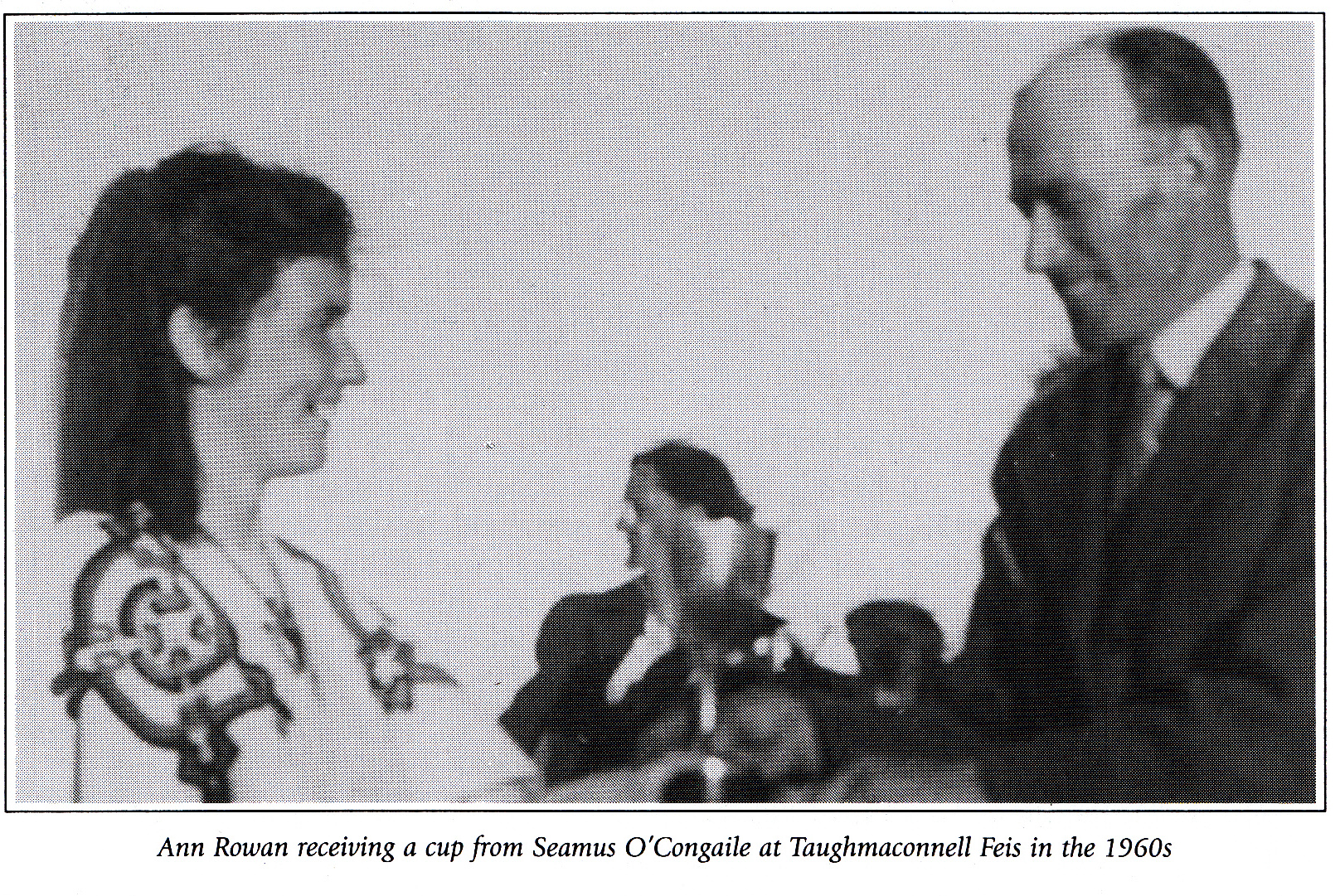
The Feis was made up of a number of events, which helped to enhance both the arts and sports in the local region. The events which were held included Irish dancing, Irish singing, recitation, marching bands, Gaelic football, and tug of war. A donkey derby was also held for two years. The Irish dancing at the Feis would stay going on until near nightfall as dance schools from all over Ireland would attend the Feis. One of the main reasons that such large numbers of contestants attended Taughmaconnell Feis was because during the 1970’s it was one of the last remaining open air Feis. The contestants competed for both a senior and junior cup in the Irish dancing event.
The football was confined to the four teams from the South Roscommon area and was a seven-aside event. A fifteen-aside event was played for one year but it proved unsuccessful as the final was played on a separate evening due to the length of time that the games went on.

A record of the gate receipt for the Feis of 1970 which was held on the 28th June of that year shows the takings on the gate to have been £307. The entrance fee on the day rvas 1s.6p. The majority of the money that was taken on the gate was spent on medals for the various events which took place. For many years the medals that were given out by the Feis committee were purchased from Timons Jewellers in Dublin. The first Feis committee in Taughmaconnell consisted of the following people:
President: Seamus O’Congaile (RIP)
Chairman: Pat Moore (RIP), Kilatogher
Secretary: Kate Ann Calvin (RIP)
Tieasurer: Martin |oe Kelly (RIP)
Committee: Paddy (Frank) Moore, Paddy Finneran, Michael Keogh,
John Kennedy, Paddy Cusack, I. Nevin, M. Glennon, Teresa Keogh
Members: Pakie Galvin, |immy Curley, Jack Brooks(RIP), Johnnie Moore(RIP)
Taughmaconnell Feis continued up until the late 1980’s when the event was forced to cease due to the increasing cost of insurance. Taughmaconnell Feis however proved itself to be one of the leading annual events for the region spanning a period of over fifty years. The last Feis committee in Taughmaconnell was made up of the following people:
Chairman; Paddy Moore
Vice-Chairman: LeoFlynn
Secretary: PhilFinneran
keasurer: SeanO’Connor
Committee: Paddy Finneran, John Feeley, Luke Kelly, Martin |oe Kelly (RIP),
Pakie Moore (RIP), P.). Fallon

Pony Racing in Taughmaconnell
Pony racing was held in the Callows at Racepark many hundreds of years ago. There is a field called the Standing Park where people would view the races from. The famous horse called Thomastown, which belonged to the Naughten family in Drum was supposed to have mn there. Races were also held in Iohn Ioe Finneran’s, Coolfree in the late 1930’s and also on Iune 9th, 1938 Confirmation Day in the Parish a big race was held to raise funds for the building of the old Priest’s house (Now Sugan). Bishop Duignan and the Parish Priest Fr. Porter appealed to the people of the parish to support the races at the time. In the later years, races were held in Jackie Costello’s field, Onagh.



Badminton
The Badminton club was formed in 1978. The first Country League was won in 1980. The club went from strength to strength over a period of years won five County League Titles and went all the way on one occasion to a Connaught Final where they were narrowly defeated. The also excelled in the Roscommon Open and Closed Competitions even winning the Sligo Open and Connaught Closed.
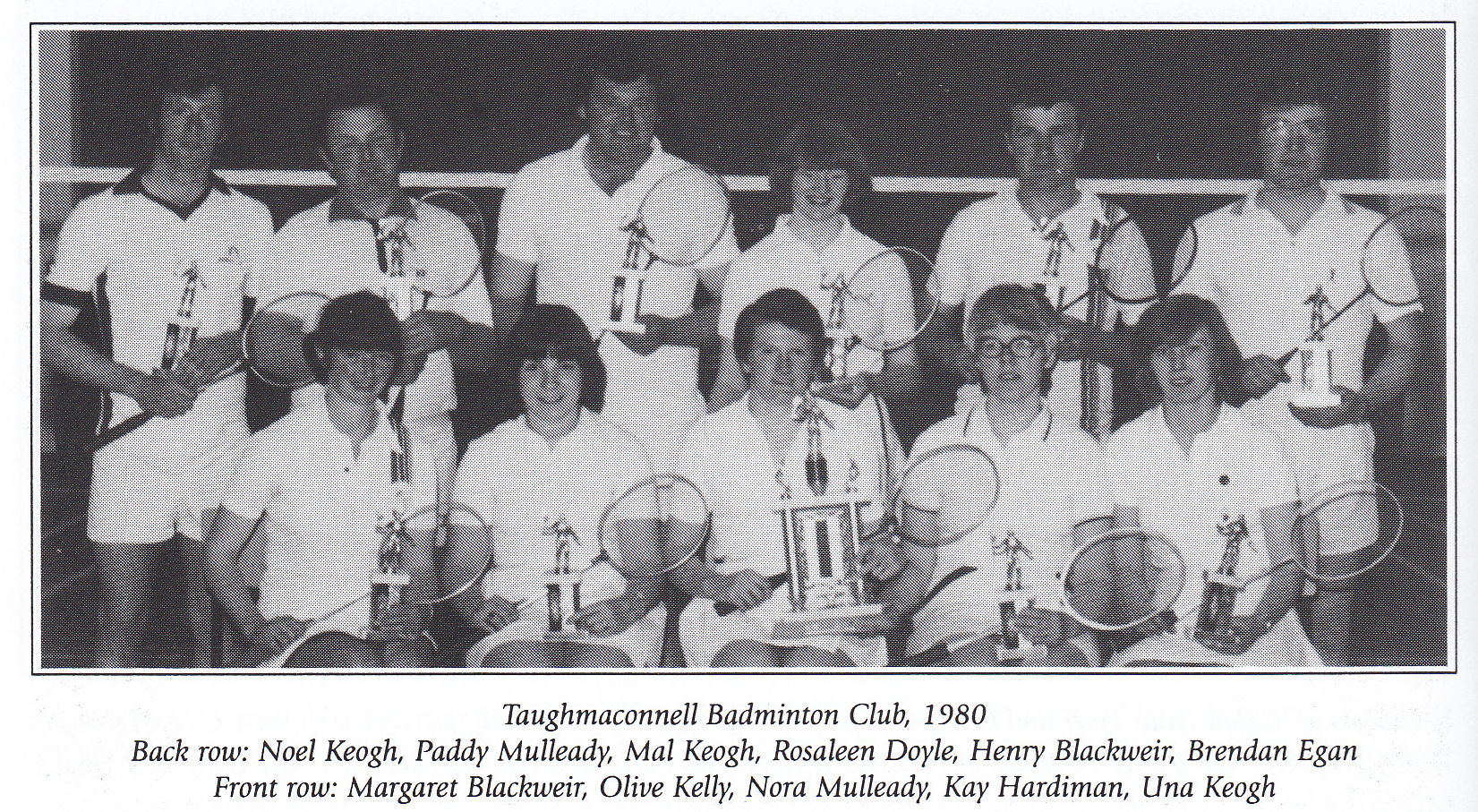
Community Centre & Groups
In December 1974 when Dundonnell National School closed after nearly 70 years as a seat of learning, Taughmaconnell Community Centre was born. The Parish Priest at that time, Very Rev Fr Campbell, retained the property for the purpose of providing social facilities for the Parish of Taughmaconnell. Being in the centre of the parish the building was ideally located to cater for all the people of the Parish. The running of the centre was handed over to the newly formed Community Centre Committee which later became known as the Hall Committee. This Committee are elected annually at the AGM.
This Committee immediately set to work. Their main ambition was to convert the Old School Building into a Modern Community centre. Throughout 1975 the Committee carried out some development work, mainly through voluntary labour. The wall at the road was removed; heating installed and seating purchased. In the early years the main source of income was from Auctions, Raffles and Card games. As soon as the centre was opened, although still very much the old School House in appearance, it became a hive of activity with many organisations using the facilities which became available.
In early 197 Bingo had proved to be a big success at the centre. The Committee of ihe time embarked on an ambitious plan which would eventually lead to the construction of the present Hall. In that year planning permission was obtained to extend the building, reconstruction plus improvements continued modernise the old building. One of the shelters was converted into a Store, the dividing wall of what had been the rear Playground was demolished along with a Shed in order to provide parking facilities. A new stage was installed and improvements were made to the lighting and heating. These improvements had become necessary to cater for the large attendance at Bingo.
The Committee at that time estimated that in excess of £10,000 would have to be raised to build the New Hall. It was decided to proceed with the project. Tw Sub-Committees were formed, each consisting of four people ( 1) A building Sub-Committee and (2) A finance sub-committee. The building Sub-Committee were given the task of drawing up suitable plans, arranging supply of materials and generally supervising the building work. People employed on an Anco training scheme carried out some of the construction work. The Finance Sub-Committee was given the responsibility of raising the necessary funds. They devised a borrowing scheme as a
means o fundraising. They set a target of £10,000 and broke it into Units of £50. Their aim was to sell 200 such Units throughout the Parish and then pay back the Investors at a later stage. Each Investor was given a Unit number which was included in Prize draws. The Borrowing Scheme proved to be a great success and building work was soon underway. The New Hall was officially opened in early 1979. When the Hall began to generate income, a lottery type system was set up to repay Investors –
Unit numbers being drawn to decide who would be repaid at a particular time.
Today Bingo continues to be the main source of Income. Over the last decade there has been a decline in the number of Groups using the Centre. One can only hope that this trend will be reversed. During 1999 in excess of £20,000 was spent modernising facilities at the centre. Further improvements are anticipated in the next few years.
The vision and foresight of those people initially involved in developing a
Community Centre in Taughmaconnell must be acknowledged. While their plans may have seemed ambitious and even extravagant at the time this Community Centre has flourished while others in similar communities have ceased to exist.

PTAA – Taughmaconnell Branch
Records show that this branch was formed on the 6th February 1933. The
following were selected to serve the association: Spiritual Director, Fr. Pelly; President, Michael Glennon; Treasurer, Michael I. Flynn; Secretary, Mary E. Flynn and the Working Group was Patrick Gately, Peter Lynch, William Galvin and Michael McManus.
In the 67 years since its foundation, we have some members who joined at the very beginning, who are alive and well and true to their pledge. Activities have varied considerably in the Pioneer Association down through the years. In Seventies’ and Eighties’ our local branch organised four European tours, as
well as many successful tours around Ireland.. Also during this period there were many concerts and plays held to packed audiences, most notable was The Artane Boys Band, who played in the Local Hall. Other activities were Swimming, Badminton, Old-time dancing and Debating’ The branch won the Iunior Badminton Final at Diocesan level in 1986 and Figure dancing in 1990 just to name but a few of our successes. we ha’e 32 junior mernbers taking part in activities such as Football, Badminton organised by the branch in the local hili e,oery Saturday night. The Iunior members are taken on Various outings, they were brought on a trip ,to Aras an Uachtarain in August ’98 which is very enjoyable, and the highlight was the Centenary Mass in Croke Park in 1999.
At present we have a very active Branch both at Senior and lunior level. In May 1933, Silver, Gold, Junior and Full Pioneer pins were presented by Fr. Sean Neylon at a specially celebrated Mass.
Under our new Spiritual Director Fr. Sean Neylon, the aims of the Branch are:
- to promote Temperance especially at underage level.
- to to ensure that our Branch will remain active well into the new Millennium.
T aughrnaconnell Dramatic Society
Taughmaconnell Dramatic Society was formed in 7946 and held its first meeting in Castlesampson National School under the leadership of Sdamus 6 Congaile. The meetings of the society rotated between Taughmaconnell and Tavanagh National Schools due to the fact that S6amus 6 Congaile taught night classes in Irish as he was a native Irish speaker from the Gaeltacht. The dramatic society was formed in order to raise funds for the building of a Handball Alley in Onagh, Taughmaconnell. Joe Mannion of Castlesampson was the contractor on the job. The first play organised by the society was a three-act comedy entitled Mrs. Mulligan’s Millions. This play was perfrormed on:
- Two occasions in Taughmaconnell School
- Once in Kilcar (Harry Burns Hall)
- Once in Kealty
- Once in Farmore School
- Once in Tubberclare School
The main characters in this play were played by:
- Kate Ann Elliot (nee Galvin)
- Martin ]oe Kelly
- Michael Keogh
- Maurice Curley
- Paddy Moore (Killatogher)
- Bridie Crehan (nee Galvin)
- Paddy Cusack
- Martin Finneran
- Paddy Moore (Franks)
Sufficient funds for the building of the Handball Alley were raised and it was constructed in 1947. The dramatic society however continued on for many years after. The folloryilg years pla1,s which were put on by the dramatic society included The Lord Mayor and this was performed in all the aforementioned venues iniluding:
- Ahascragh
- Kiltormer
- Centex
Val Costello was an additional member to the cast. Other members who joined the dramatic society and featured in many of its productions included:
- Frank Greene
- Johnny Moore
- Tommy Crehan
- Teresa Fallon (Camala)
- Dilly Moore (nee Carty)
- Pat Galvin (Castlesampson)
- Bridie Daly
The Dramatic Society started.to learn plays over the winter period and the plays were acted over the seven Sirnday nights of Lenl. The Dramatic Society continued well after the Handball Alley had been built.

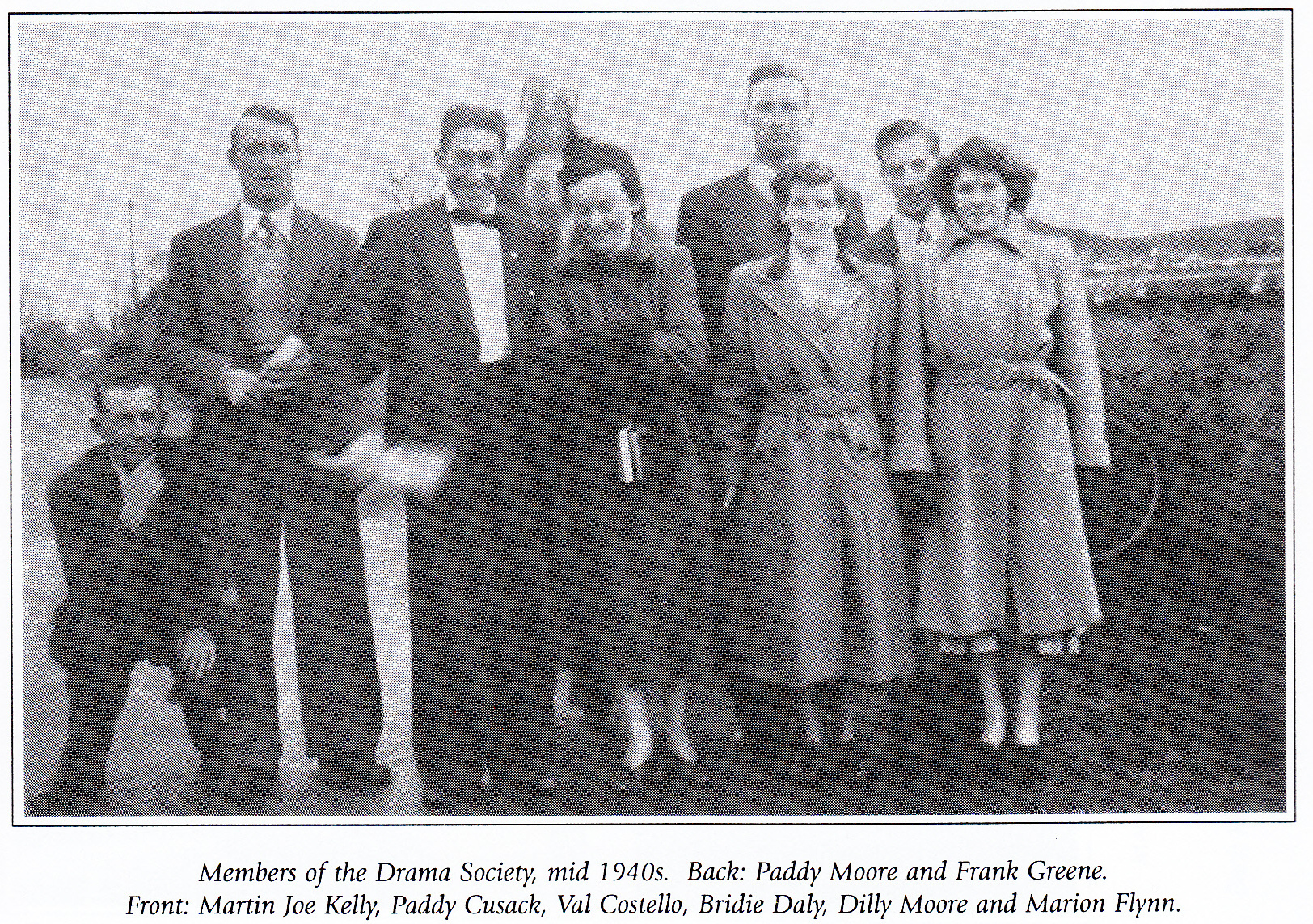
Taughmaconnell branch of the Irish Countrywomen’s Association
Thq Taughmaconnell branch of the Irish Countrywomen’s Association ((l.C.A.) was formed early in the 1970s by a group of women that included Maisie Finneran, Gertie Naughton, Dillie Moore, Kathleen Keogh and Eileen Finneran. They met once a month in the old school and at one stage they had about 70 members. Their activities included getting people to come and talk about Cookery Crafts, Gardening, First Aid etc.
The I.C.A. also used to organise tours to places like Killarney and Cork. Every year 2 people from the local branch were selected to go and spend a week in the National I.C.A. Headquarters at An Griandn in Termonfeckin in Co. Louth.
